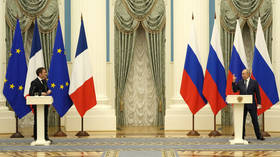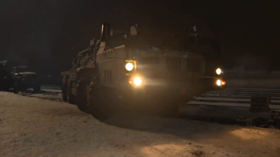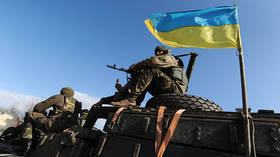Biden’s got just three options left on Ukraine, and none that’s palatable for him

As Europe teeters on the brink of war over Ukraine, the administration of President Joe Biden finds itself entangled in a policy nightmare for which there are no ready solutions.
Just a short time ago, the administration of Joe Biden was confronted with a regional national security problem – the crisis with Russia over Ukraine – where the worst-case scenario ended with the Russians invading and the US leading a global coalition of the willing in imposing massive sanctions against Moscow as punishment. The consequences of such an outcome – economic pain for Europe and the US, and possible fractures on the periphery of EU/NATO unity – were considered manageable over time.
Today, the US is facing a completely different game. Russia and China have united in a relationship that transcends an alliance, promoting a “law-based international order” which challenges the Biden administration’s foundational “rules-based international order” dogma. And in the aftermath of a meeting with French President Emmanuel Macron, Russian President Vladimir Putin warned of a possibility of a nuclear conflict that would see “no victors,” should Ukraine join NATO.
The Ukraine crisis just got serious, and as such, the Biden administration must now begin to consider serious options in bringing this crisis to a close.
Option One: War
Simply put, war is not an option Washington would willingly choose. First and foremost, even if the US were seriously considering Ukraine as a fellow NATO member, there is simply no way that the military alliance could garner the support of all 30 members for an action which would be tantamount to collective suicide.
But, given the escalation in tensions that has transpired over the course of the past few weeks, with Russia deploying tens of thousands of troops into Belarus (Moscow has said troops will leave the country after the end of ‘Union Resolve 2022’ joint exercises later this month), and the US and NATO deploying thousands of their own forces into eastern Europe, the possibility of the resulting tinderbox being ignited into a wider conflagration cannot be discounted. As the assassination of Archduke Francis Ferdinand in 1914 demonstrated, world wars have been triggered by minor events.
This is particularly so in Ukraine, where Poland and the United Kingdom, both NATO members, have talked about a trilateral security arrangement with Kiev outside of the military bloc’s framework. The pouring in of hundreds of millions of dollars of military material, accompanied in many cases by military trainers, is imbuing Ukraine with a false sense of security. If Ukraine ever were to believe that it had the direct backing of Poland and the UK, and the indirect support of the rest of NATO and Europe, it can’t be completely ruled out that it could initiate a military operation designed to return the Donbass region to Ukrainian control. But that may hypothetically lead to a scenario similar to that of 2008, when Russia recognized the independence of South Ossetia and Abkhazia following a brief war with Georgia that started after Tbilisi tried to seize its breakaway regions by force, killing scores of civilians and Russian peacekeepers.
Any rational military/geopolitical analyst would discount Kiev’s offensive as a non-starter, and as such dismiss its likelihood of occurring out of hand. Ukraine, however, is quite often not a rational actor.
Around 73% of Ukrainians voted for Volodymyr Zelensky when he ran for president in 2019; today, his popularity rating has fallen to around 23%. Beset by domestic problems, Zelensky has helped stoke fears of a Russian invasion while seeking to dampen down the prospects for its short-term implementation – as he has discovered, the prospect of war does not create a favorable climate for the kind of international investment Ukraine desperately needs. So Zelensky has his foot dancing on the accelerator of the current crisis, giving gas when he needs international attention, and easing up when he needs to create a sense of stability.
When it comes to issues of war and peace, the last thing either Biden or Europe needs is an unstable Ukrainian politician having his finger on the trigger of a conflict that could result in a nuclear holocaust. In short, to avoid a war with Russia, the US will have to take the trigger for such a conflict out of the hands of the Ukrainian president.
Option Two: Compromise
Russia has made its demands regarding the current crisis quite clear, spelling them out in a pair of draft treaties presented to the US and NATO. In short, Russia is demanding not only the end of NATO expansion, but also a reconfiguration of NATO military capability to pre-1997 levels. To date, the US and NATO have rejected the Russian demands, setting up the current confrontation.
Neither the US nor NATO can back down from their entrenched position that the military bloc’s so-called ‘open door policy’ regarding membership is non-negotiable. However, as the recent visit by French President Emmanuel Macron to Moscow illustrated, there is an appetite for a solution where NATO retains its open door policy while precluding active consideration of Ukrainian membership. Macron alluded to the possibility of the ‘Finlandization’ of Ukraine, where Ukraine adopts a neutral status formalized by treaty-like agreements, thereby removing itself from consideration for NATO membership.
While Ukraine has yet to see the wisdom of such an arrangement (one which most likely means the end of Zelensky’s political career, given the personal and political investment he has made for NATO membership), the fact is Ukraine has no vote on the matter. If the US and Europe want to avoid the prospects of a costly (and potentially fatal) military conflict with Russia, the possibility of Ukrainian membership in NATO must be permanently excluded.
There would be room for a grand compromise here, if it were not for the harsh realities of domestic American politics. Biden appears to be on the cusp of reaching a compromise agreement with Iran regarding the resumption of US membership in the Joint Comprehensive Plan of Action (JCPOA), or Iranian nuclear agreement. If this deal is reached, Biden will find himself under attack from Republicans in Congress. Biden is vulnerable to such criticism, given the recent debacle surrounding the evacuation of Afghanistan. In American parlance, three strikes and you're out – with Afghanistan and Iran, Biden has two strikes. With a critical mid-term election approaching in November that will decide not only which party controls Congress but, by extension, the future of Biden’s legislative agenda, a third perceived national security policy failure could prove to be politically disastrous.
Getting Ukraine to neutral is the key. Here, the Biden administration will need to let Europe take the lead, allowing the US president to retain a hardline posture while acceding to ground truth as defined in Paris, Berlin, and Kiev. This could take some time, but the basic foundational components of such a compromise are already in place – the operation of the Nord Stream 2 pipeline in exchange for the continued flow of gas through Ukrainian pipelines (thereby guaranteeing Ukraine access to billions of dollars in transit fees), and a ‘freeze’ on further military deployments into the region. This would see the US and NATO stop sending forces to eastern Europe, while Russia halts its deployment of troops in the vicinity of Ukraine and Belarus.
The next move would be to create a package of economic and security incentives that could help move Ukraine toward accepting the new reality of self-imposed neutrality. This would not happen overnight, but if such a path was taken, these incentives could be combined with a general de-escalation which saw US and NATO forces pull back from eastern Europe in exchange for Russian forces returning to their barracks, all while broader negotiations were held on other issues of regional security importance, such as intermediate nuclear forces, military exercises, and additional confidence-building measures that reduced the potential for inadvertent conflict.
If managed properly, such a course of action would give Russia most of what it has demanded, but delivered in a manner which made the outcome look less like a surrender and more like a pragmatic compromise.
The primary roadblock is political – would the US be able to pressure Ukraine into accepting such an outcome, and could Biden survive the inevitable domestic political backlash that would occur?
Option 3: Maintain the Status Quo
Doing nothing is sometimes seen as the most expedient, and therefore most attractive, option. From the perspective of the Biden administration, it has boxed Russia into a difficult situation where the onus is on Vladimir Putin, not Joe Biden, to seek compromise. This calculation requires one to accept an interpretation of the current situation that has Russia on the defensive, and that the situation would remain static for the time being.
The status quo, however, is not conducive to the rosy picture painted by the Biden administration. Rather than being boxed in, Russia appears to have plenty of room for maneuver, as indicated by Macron’s visit to Moscow, and the future visit by new German Chancellor Olaf Scholz. The Normandy Format is active, and Russia’s burgeoning relationship with China is throwing the various calculations of Russian vulnerability to US-led sanctions into the wind.
But all the above is fact-based reality; the Biden administration operates in the realm of domestic political perception, and managing that perception takes precedence over embracing fact, especially during a critical election year. For Biden, maintaining the status quo allows him to look strong in the face of perceived Russian aggression, and to use this projection of strength to breathe life back into a NATO alliance deeply scared by the Afghan experience, and desperate to be seen as relevant.
From the White House’s perspective, the status quo allows the US to continue to articulate a Putin-centric assessment of Russia, further demonizing that nation in the eyes of the American people. ‘Standing up to Russia’ historically plays well at the polls, a fact that Biden certainly would like to be able to exploit going into critical midterm elections.
Unfortunately for Biden, the geopolitical reality is not static, but ever changing. The more Biden seeks to ‘freeze’ the crisis with Russia at manageable levels, the more he empowers Zelensky with the ability to trigger a war with Russia. Likewise, with China now fully engaged politically on the issue of Ukraine, any attempt to rest the moral argument underpinning the status quo – namely the mantra of a ‘rules-based international order’ – makes more powerful the counterargument being promulgated by Russia and China, built on the premise of a ‘law-based international order’.
From a purely logical standpoint, maintaining the status quo is not a viable solution, as it will inevitably lead the US back to either war or geopolitical defeat. Unfortunately, it is the most likely outcome, given the domestic political realities confronting Joe Biden. If a more pragmatic path, such as the one offered by the promise of Ukrainian neutrality, is to be viable, it will require extraordinary leadership and vision from both Europe and Russia.
Biden’s best option, it turns out, is to follow the age-old maxim: “Lead, follow, or get the hell out of the way.”
The statements, views and opinions expressed in this column are solely those of the author and do not necessarily represent those of RT.
















